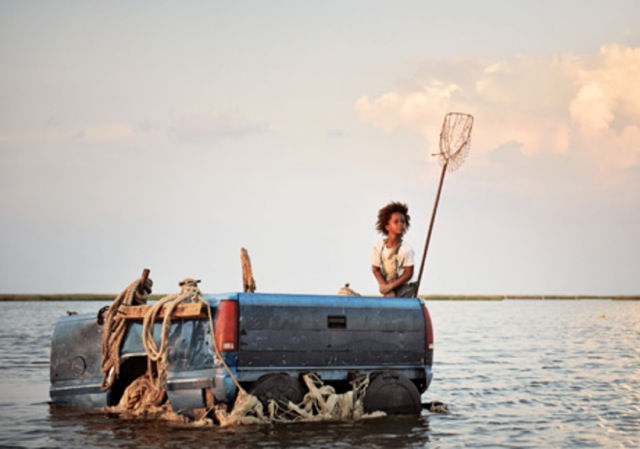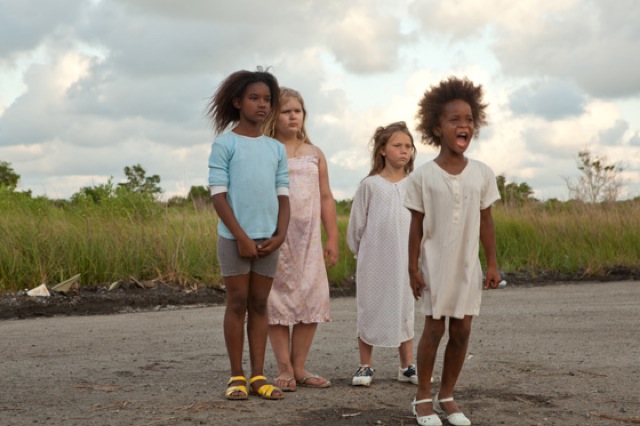To say that Beasts of the Southern Wild was filmed in southern Louisiana understates the case—it seems like an enormous construction made from pieces of southern Louisiana, and inhabited by the people that the film’s young director, Benh Zeitlin, a New Yorker who has been living in New Orleans since 2008, found there. Yet this is no documentary but a work of purest fantasy, set in a world just adjacent to the real and operating with all the liberties of folklore.
We are somewhere south of New Orleans, beyond the levee, on a perpetually endangered floodplain settlement called the Bathtub, a sort of multiracial Eden sustaining itself on wildlife and debris: a loosely linked bayou community below the radar and off the grid. Here the water seeps into everything. We are outside history, outside sociology, caught up straight away in the territories toward which Huck Finn lit out or in the swamp at the end of the mind, a messy profusion of fiddle music and moonshine. They are wild people living among wild things, unconstrained by laws or walls, reliant on ancient prophecies and herbal cures, at home with the water that may overwhelm them at any moment. It hardly matters whether we are in paradise or perdition. Perhaps it is perdition transmuted by sheer cussedness into paradise. In the floating life of the imaginary, opposites merge with an easy profundity; it’s just what the imaginary is made for.
The waterlogged environment gives Zeitlin a wraparound, ever-present metaphor for the way his film permeates barriers. We soak it up, or dissolve into it. From the start there are rumors of impending flood, apocalyptically couched, as a teacher tattooed with archaic images of aurochs tells her young charges: “Any day now the fabric of the universe is coming unraveled.” In short order we endure storm and deluge, move forward into a future of poisoned waters and prehistoric beasts resurrected from melting ice caps, and return at last to the primal swamp as part of an enduring remnant in a drowned world.
They are us, these survivors, because what Katrina and other hurricanes did to the gulf coast can be taken as a foreshadowing of worse to come. The movie is a sort of primitivist-futurist extravaganza made by hand with the fragments of actual disaster. Yet the note sounded throughout is not the terror of catastrophe—although we see the marks of catastrophe on every hand as we glide past submerged and damaged habitations—but the slim exhilarating margin of survival, the dance on the last bare edge of dry ground. (The film, it should be noted—it is Zeitlin’s first feature—was conceived during his long recuperation from a near-fatal car accident.)
In movies the imaginary tends to be expensive, so independent live-action films generally work with what is already in place and steer clear of the realms of large-scale fantasy. Our dream worlds are elaborated for us by corporate entities with the necessary means. Beasts of the Southern Wild represents a kind of protest against this state of affairs, an assertion of the right to build one’s own make-believe world, with available tools however rudimentary, rather than submitting to the pre-imagined products of Disney, Marvel, Pixar, and the rest. It’s a film made cheaply, and I would imagine sometimes dangerously, with amateur actors and dwellings furnished with the detritus of floods and storms. It makes up its mythology analogously to the way a child might make up a history of the world, with the gaps and unexpected detours and lurching transitions intact.
The child here is Quvenzhané Wallis, an African-American girl who was discovered in a Louisiana elementary school and was six years old when the film was made. It’s hard to imagine what the movie might have been without her. She plays Hushpuppy, whose mother “swam away” (sometimes returning as a disembodied voice) and whose father (played in mingled tones of ferocity and tenderness by a New Orleans baker, Dwight Henry) appears to be dying. Hushpuppy in a sense is the whole movie. What we see is her understanding of how things are—if her father goes missing, it can only be that “daddy woulda turned into a tree or a bug,” and if she listens to animals they tell her what’s on their minds—and it can only be as persuasive as she is.
Everything is mediated through her, on the one hand the unlimited turbulence of the phenomenal world (including the contradictory behavior of a father who in one scene rejects her and in another showers her with love) and on the other hand a child of almost preternatural seriousness and focused energy. The story, as we piece it together, is the perennial fable of the child who must save her father, her community, her world. Accomplishing this involves no magic formula but the mere assertion of will in the face of all terrors, like her father who as the storm descends on them fires a rifle into the raging skies in defiance.
Advertisement
Wallis’s tiny presence is commanding—intense, unflinching, incapable of meek submission—and her manner is far from the winsome ways of most child actors. She is given some large philosophical statements to pronounce—“The entire universe depended on everything fitting together just right”—and by her stance establishes herself as one of those indispensable things on which the universe depends. She is a believable hero because with our own eyes we can see her perform the heroic feat of sustaining an epic film, and in the end accept that her assured glance can indeed (in an image that recalls the world of Maurice Sendak) make predatory beasts kneel before her.
Apply real-world logic and this watery alternate world is in danger of dissolving, like a dream colliding with morning light. When, near the halfway point, a rescue team from the modern world arrives by helicopter to evacuate the residents of the Bathtub and carry them off to a crowded disaster relief center, the movie itself comes uneasily close to losing its delicate balancing of the real and the unreal by a sudden intrusion of inevitable skeptical questions. The rescuers figure as a malevolent intrusive force even though we haven’t been given a clear reason to see them that way. It may well be that flood victims suffering from the effects of exposure and hunger would want nothing more than to escape from the shelter where they are receiving food and medical care in order to return to their flooded homes, but Zeitlin does not do much of anything to show why.
A shot of Hushpuppy in the disaster center wearing an anachronistic Little House on the Prairie-style dress evokes the notion of the wild child “civilized” by well-meaning missionaries, and the center’s ambiance is that of an overcrowded and understaffed clinic operating under very disadvantageous circumstances. But the moments when she and the other Bathtub residents flee together from the shelter, racing across a parking lot toward the bus that will take them back home—as if they had been liberated and were on their way to the Promised Land—are the least effectively realized in the movie. We can all recollect the much-reported horrors of the athletic arena where survivors were crammed together after Katrina, and Zeitlin may be relying on such recollections, but nothing we see here seems as horrific as it’s evidently meant to be. The shelter has to stand in for the modern world that is otherwise absent from the film, the soulless land only glimpsed from a distance on the other side of the levee.
In the end the film finds a more congenial disaster center in the lake boat that Hushpuppy and some of the other children board in a search for food, with a skipper likewise given to philosophical musings—“This boat’ll take you exactly where you need to be”—and with a turntable that plays only one record, Fats Waller’s “Until the Real Thing Comes Along,” spinning over and over for whores and boatmen as if it were the last record on earth, an oldie dredged up from the flood. This boat of dreams seems almost designed to conjure up the most authentically dreamlike of American movies, Charles Laughton’s The Night of the Hunter, an equally water-soaked work of the imagination.
I wonder if anyone has undertaken a study of Water and Movies. It is a subject of almost infinite application, starting from the earliest registering of the movement of waves and rivulets by cinematic pioneers. It is the most privileged element in film because it exercises cinematic power merely by being filmed. The bodies of water that have served as crucial staging grounds would make a catalog of the most intense moments in cinema, from the waterfall with which Buster Keaton contended in Our Hospitality to the lotus pool where June Duprez caught sight of John Justin’s reflection in Alexander Korda’s The Thief of Bagdad, from the misty lake across which Kinuyo Tanaka and her children were unwittingly ferried toward misfortune in Mizoguchi’s Sansho the Bailiff to the bay from which James Stewart rescued Kim Novak in Hitchcock’s Vertigo, and on out to the ocean where the doomed hero of Murnau’s Tabu sank beneath the waves. In all that profusion there are some few films where the watery element so predominates as to create a kind of pool for the mind: Jean Vigo’s L’Atalante was one such, Beasts of the Southern Wild is another.
Advertisement



